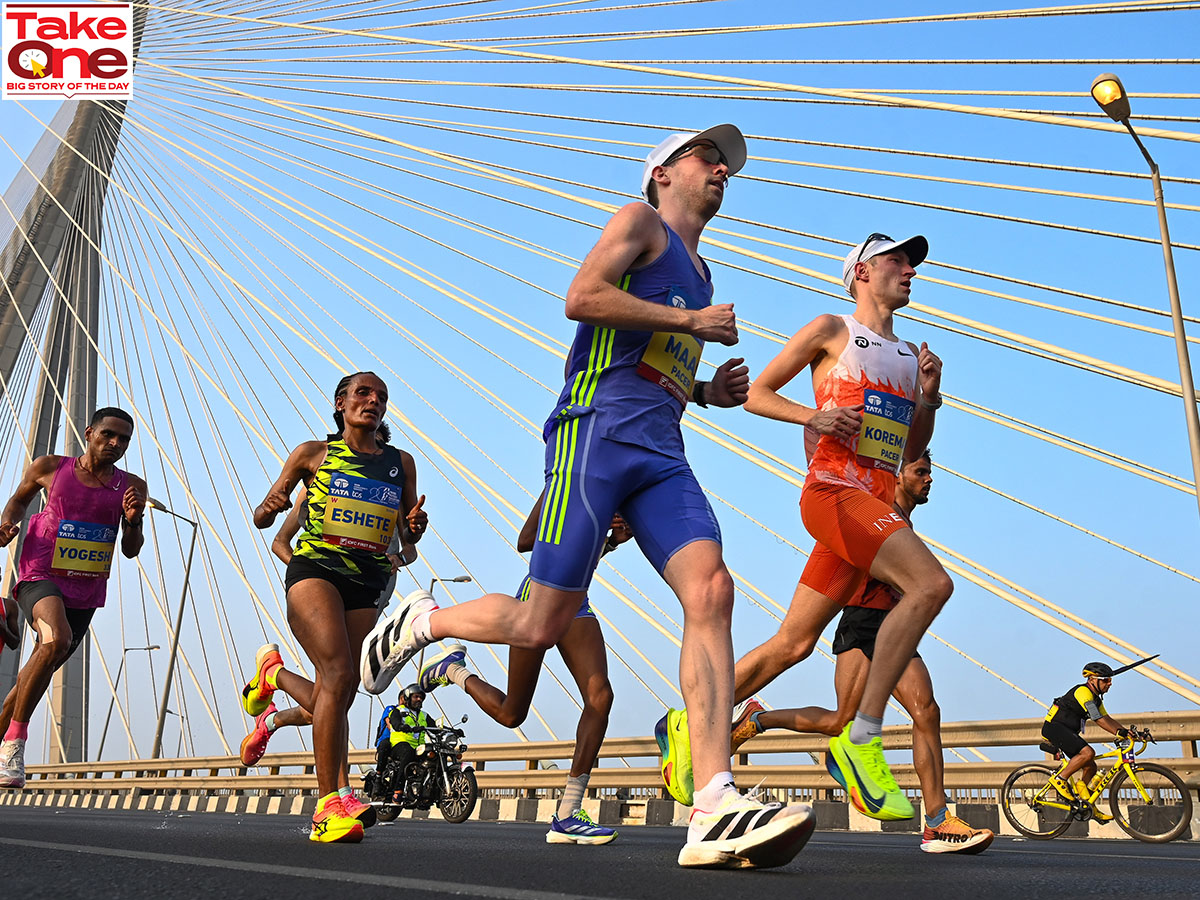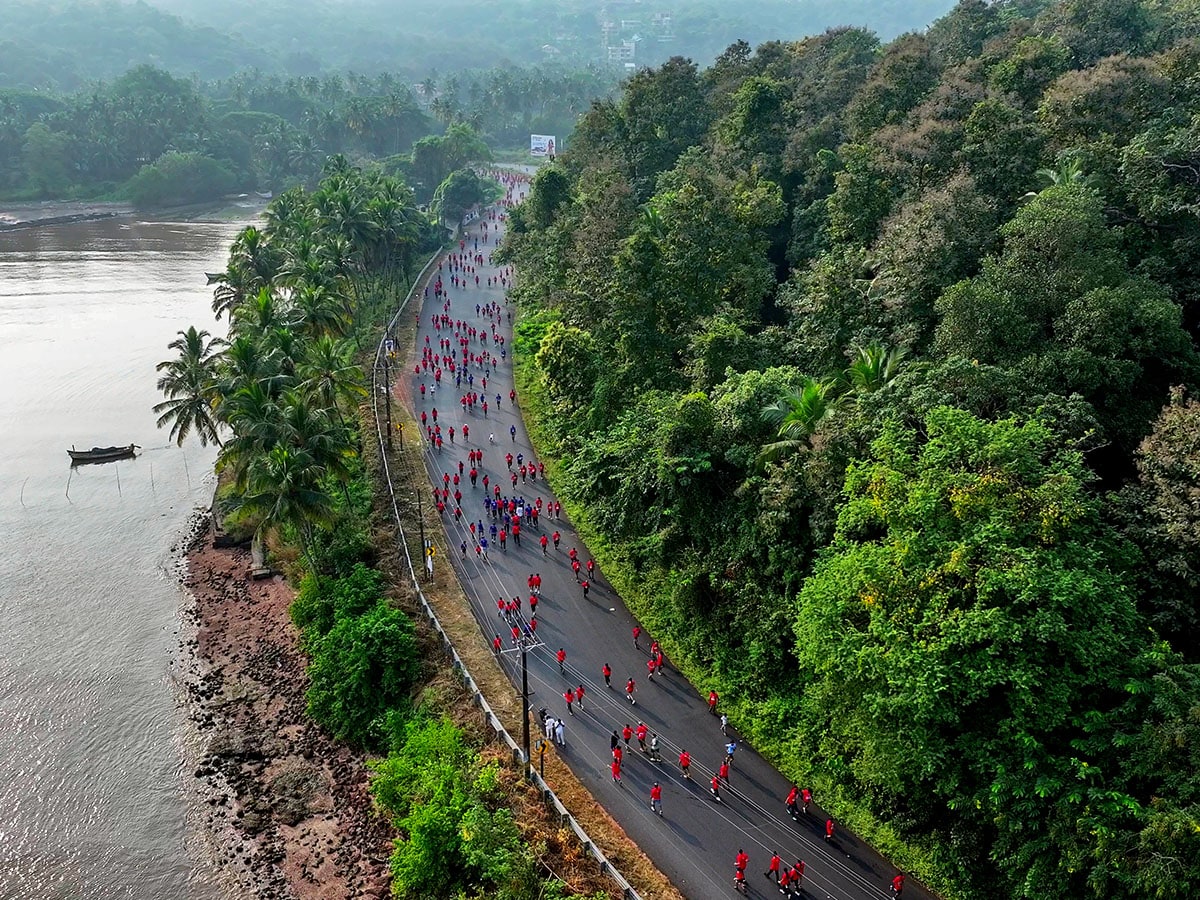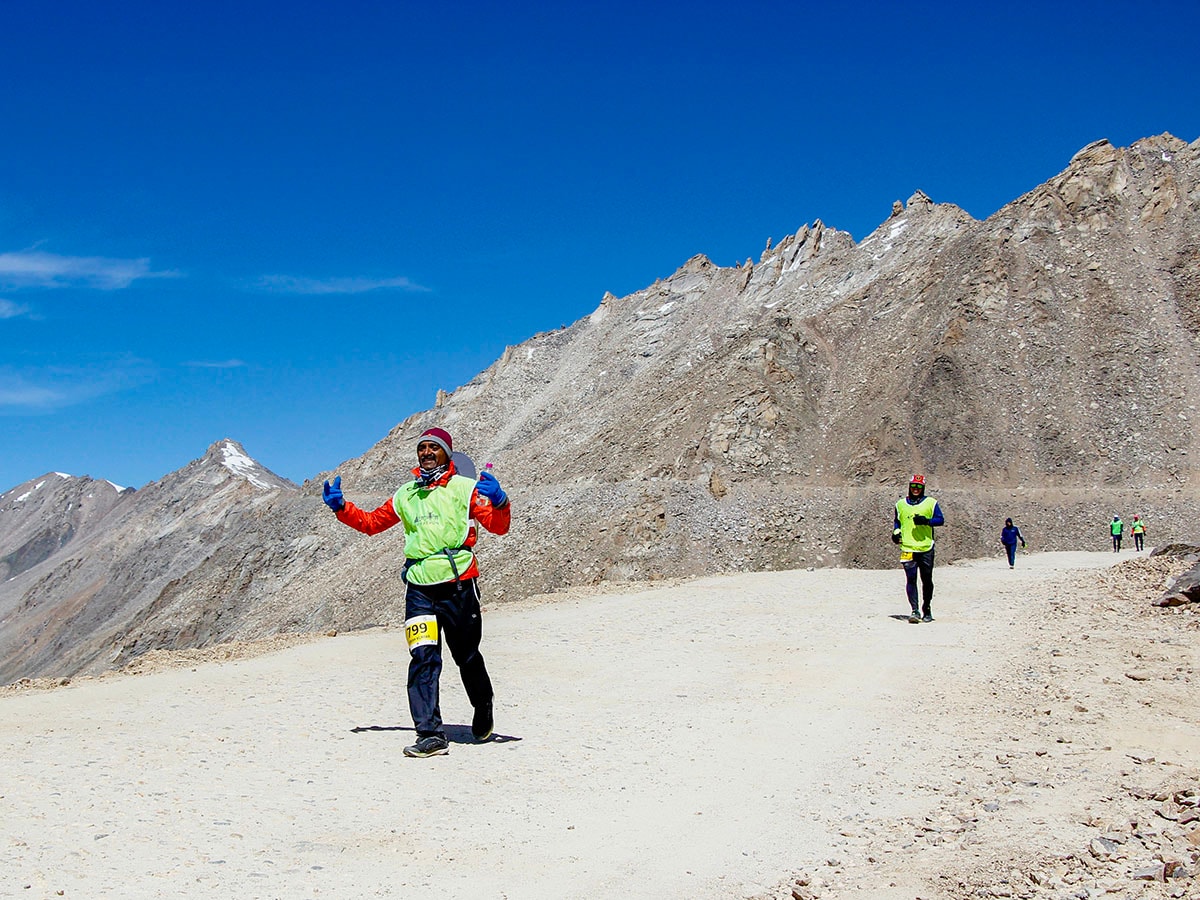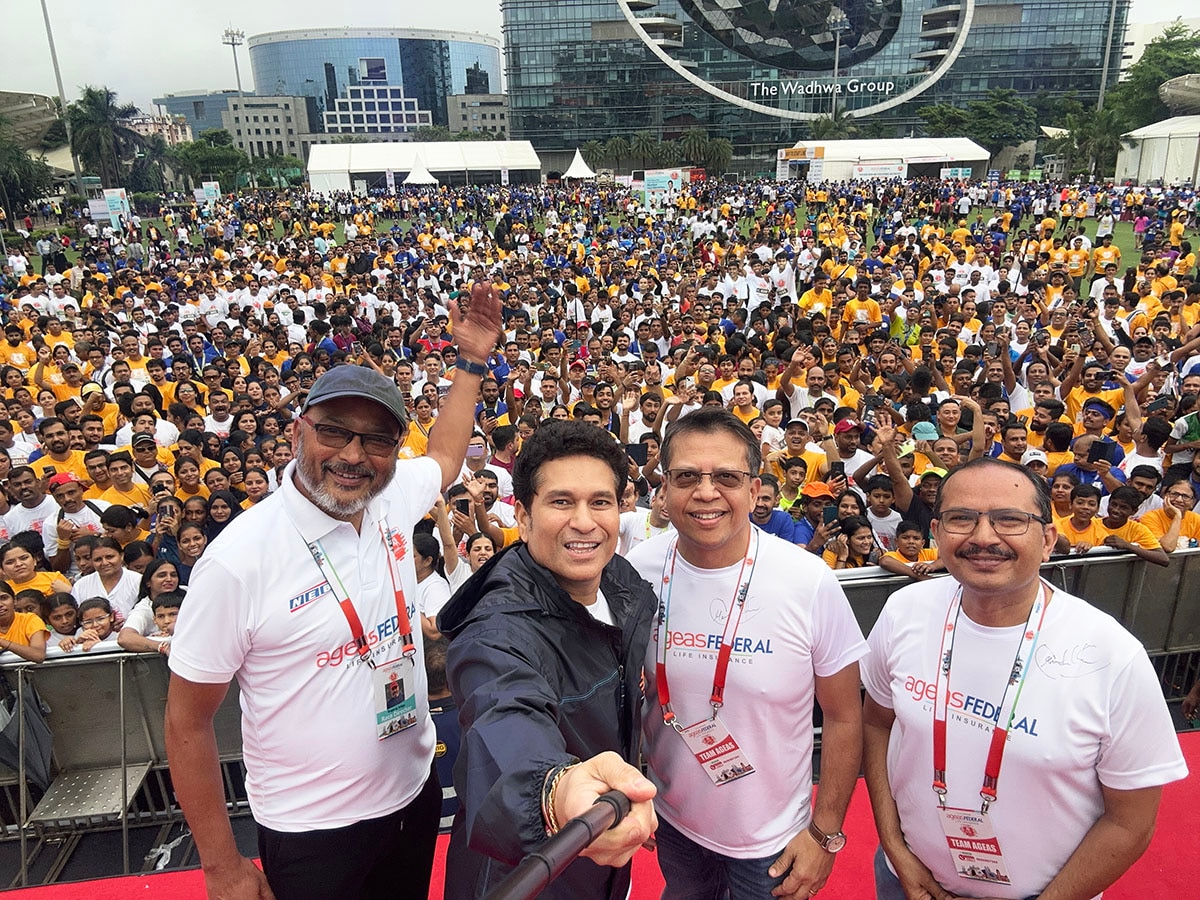 Runners cross the Bandra-Worli Sea Link during the Tata Mumbai Marathon on January 19. The marathon, which completed its 20th edition, is a World Athletics Gold Label race. 19th January, 2025. Image: Raju Shinde/Hindustan Times via Getty Images
Runners cross the Bandra-Worli Sea Link during the Tata Mumbai Marathon on January 19. The marathon, which completed its 20th edition, is a World Athletics Gold Label race. 19th January, 2025. Image: Raju Shinde/Hindustan Times via Getty Images
On Sunday, as nearly 60,000 runners took to the streets of Mumbai (and a few thousands more joined online) to kick off the landmark 20th edition of the Tata Mumbai Marathon (TMM), brothers Anil and Vivek Singh of Procam International would have experienced nothing short of a runner’s high. Their mind would have flashed back to 2004 when they took the audacious bet of launching the race in Mumbai. Says Vivek Singh, the joint MD, “We didn’t even know if anyone would turn up. There were barely 10,000 registered runners in the country then and just two organised, structured races.” One of the top corporations laughed at their plea of Rs 4 crore for title sponsorship and the civic authorities balked at their request to shut down Marine Drive for the runners.
But the duo kept at it. They eventually raised Rs 6 crore through sponsorships; on race day, defying expectations, somewhere between 15,000 and 18,000 runners turned up; the governor, chief minister and deputy chief minister were in attendance; and the iconic stretch of Marine Drive did indeed close down. “We’ve only grown ever since,” says Singh. Overall, too, the number of registered runners has increased to 2.5 million, from 10,000 in 2004, while there are at least 800 timed runs and more than 700 run clubs in the country today, Singh adds.
The number has gone north even in the ultra-running events (which are longer than the traditional marathon of 42.195 km and usually pass through terrains that are a test of endurance). One of the race categories at the Ladakh Marathon is the arduous Khardung La challenge, which that starts at 13,000-odd feet, crosses the Khardung La pass at 17,618 feet, before going downhill to complete a 72-km course. The number of participants in the race in the first year, in 2012, stood at 11. “Most of them were members of my ice hockey club. I forced them to run,” says Chewang Motup Goba, founder and race director, Ladakh Marathon. “In 2024, we received 311 registrations, of which 281 runners joined the starting line.”
 The Goa River Marathon started with only two local business houses as sponsors, but now has 7-8 commercial partners. Its title sponsor SKF has signed with the race till 2030. Image: Courtesy Goa River Marathon
The Goa River Marathon started with only two local business houses as sponsors, but now has 7-8 commercial partners. Its title sponsor SKF has signed with the race till 2030. Image: Courtesy Goa River Marathon
Growth of an Ecosystem
As the numbers keep rising, the exponential growth of participative running in India becomes evident. It has created a catchment of captive audience for brands who are now flocking to engage with races. TMM, for instance, onboarded 13 sponsors for its 2025 edition, up from seven in the first edition; its joint title sponsor TCS also sponsors 14 endurance running events around the world. “The 2024 Brand Finance Report ranked TCS as the second-most valuable brand in global IT services, with brand value increasing 11.5 percent year-over-year. In just 14 years, TCS’s brand value has gone up nearly ninefold and stands at $19.2 billion, driven in part by strategic investments in sports sponsorships,” says Michelle Taylor, head of global sports sponsorship for the company.
Not only have the participation numbers, but Procam’s revenues from TMM jumped over 11x, to Rs 70 crore (through sponsorship, barter and registration fees), for its 2025 edition, and its revenues from the four races it promotes (across Mumbai, Delhi, Kolkata and Bengaluru) have risen to about Rs 150 crore, compared to Rs 80 crore in 2014, the first cycle in which all the four races were held.
But, more importantly, en route, it built an ecosystem, stoking the interest for running in other parts of the country. For instance, a group of half-marathoners at the Mumbai marathon in 2009 got together to launch the Goa River Marathon (GRM) in the state the following year. From 350 runners in the first year, the GRM received nearly 5,000 registrations in its last edition in 2024. In its first year, the race started off with two local business houses as sponsors and raised a total of Rs 6 lakh in sponsorship revenue; now it has 7-8 commercial partners and the latter has reached about Rs 40 lakh. NEB Sports, which organises 14 races across eight cities, raised Rs 20 crore in sponsorship in FY24, with 15 key brand partners, while the Ladakh Marathon has found six commercial partners for its 2024 race as opposed to zero in 2016.
“Running in India is now a $450 million a year industry,” says Singh of Procam. “This growing ecosystem is the answer to your question why brands are coming to partner with races.”
Also read: Running is the fastest growing sporting activity in India: Anil and Vivek Singh
The Brand Lens
Brands echo Singh’s sentiments. “Running is the fastest-growing segment in India and we are seeing massive double-digit growth in participation year-on-year. For Puma, running as a category is growing faster than our overall growth,” says Shreya Sachdev, associate director and head of marketing, Puma India. The pandemic acted as a catalyst as the sportswear company saw nearly triple digit growth in purchases for running.
Among the key races, Puma India supports the Vedanta Delhi Half Marathon (a Procam event), the Ladakh Marathon as well as the Adani Ahmedabad Marathon, while also backing smaller races, weekly runs in various cities (numbering 250-odd in 2024), and investing in its own IP, the Nitro Runs. “For running shoes, people typically don’t buy them because some celebrity is wearing them. They do their research, talk to peers, watch marathoners and make their decision,” adds Sachdev. “For us, on-ground presence is as important as other channels, if not more, when it comes to ATL [above the line—advertising through mass media] campaigns. That’s the cornerstone of how we activate the Nitro collection, a tier-one performance shoe that we launched in 2021.”
Like Puma, Bisleri, which sells water that is intrinsic to hydration during runs, partners with over 20 major running events, including TMM and the Ladakh marathon. “Recreational running is a big trend with a focus on health and fitness in the post-pandemic world. A number of research studies show that Gen Z consumers especially view running and hydration as two key enablers for a fitter and healthier life,” says Tushar Malhotra, director-sales and marketing of the company, which brought out limited edition bottles for TMM, featuring Indian elite runners like Man Singh, Nirmaben Thakor and others. Bisleri is also looking to ramp up their association with running as a long-standing strategy, Malhotra adds.
The government and administration support has also energised the running movement for brands. Be it the state government in Goa, the likes of the UT administration, Indian Army, ITBP in Ladakh or the Mumbai Police and the MCGM, among others, for the TMM, the growth of participative sport has come at the behest of the powers-that-be. With events like Khelo India, the police runs, there is greater awareness among the society.
“Add to that, the corporate runs for their employee engagement, and these mean the conversation points come across multiple areas in our life. It makes the brands open up to these spaces. They know that whenever there is a run, they can reach out to multiple segments,” says Cauvery Adiga, COO, NEB Sports.
 The 72-km Khardung La challenge had 11 runners in 2012, its inaugural year; in its 2024 edition, 281 runners joined the starting line of one of the toughest races in the world. Image: Courtesy Ladakh Marathon
The 72-km Khardung La challenge had 11 runners in 2012, its inaugural year; in its 2024 edition, 281 runners joined the starting line of one of the toughest races in the world. Image: Courtesy Ladakh Marathon
The Unusual Partners
But, in the early years, convincing brands to sponsor races wasn’t easy. In order to offers brands greater visibility in return for multi-year deals, NEB, which conducts multiple races—from the popular Ageas Federal Mumbai Half Marathon to the niche Kaveri Trail Marathon and the Kodagu Monsoon Half Marathon—began to organise training runs free for those who had registered for the big races. Says Cauvery Adiga, COO, NEB Sports, “That idea caught on with everybody and that also became a USP with the brand because then the visibility is over a period of six months and not just the race day.” In FY25, Adiga expects NEB’s sponsorship revenues from 14 races to touch Rs 35 crore.
The races also become a platform for brands, without an obvious connect to athletics, to amplify their voice. Hence, the likes of insurance company Ageas Federal became the title sponsors of the Mumbai half marathon, tech behemoth TCS for the Kolkata 25K and the Bengaluru 10K races, while mining conglomerate Vedanta assumed a similar role with the Delhi half marathon.
Says Narayan TV, chief marketing officer, IDFC First Bank, an associate sponsor of TMM, “Sponsoring running events has significantly contributed to our marketing efforts. We want to build our brand not just through conventional methods but as a combination of sponsorships, conventional media buys as well as highly targeted digital content and media formats.”
Adds Narayan: “In that respect, our association with the running community is highly experiential and in-person since these appeal to people across age, income profile, geographies and is inclusive. We have observed increased brand awareness and engagement among our target audiences, particularly among health-conscious individuals and active lifestyle enthusiasts.”
In one of the most unlikely such matches, Puma, in November, tied up with dating app Bumble to organise in Bengaluru a singles-only running event for those between 18 and 35 years; the event concluded with a mixer at Social. Why would a company like Bumble throw its hat into the ring? “People are increasingly seeing running as a social activity. This is something Bumble has also realised from their survey, in which 72 percent of Indians said they were open to going on a sports-themed first date and 44 percent considered the lack of interest in sports as a dealbreaker,” says Sachdev of Puma India. The inaugural edition of PumaxBumble, with 200 participants, has given Puma the confidence to consider scaling it up in future.
Sometimes, partnerships come in to fill in key functions of a race. Example: Bajaj Allianz has tied up with the Ladakh Marathon to provide mandatory insurance to runners, given the low oxygen levels that can pose health threats, while IndiGo Airlines is the travel partner in a race where over 80 percent of runners come from outside the state. Besides, brands often want to create multiple touchpoints. “For example, Apollo Tyres is a title sponsor for the New Delhi marathon set to take place in February, but they would also want to be associated with a Pune or a Chennai race, giving them visibility across races in multiple cities,” says Adiga of NEB Sports.
 Sachin Tendulkar flags off the Ageas Federal Mumbai Half Marathon organised by NEB Sports. Image: Courtesy NEB Sports
Sachin Tendulkar flags off the Ageas Federal Mumbai Half Marathon organised by NEB Sports. Image: Courtesy NEB Sports
When Principles Align
But races also come from a place of passion in which brand partnerships come secondary to the race objectives. One example would be a brand that came in to sponsor the GRM, but parted ways later since the race wasn’t keen on scaling up beyond a point. “Ours is a niche race and we can only grow so much if we have to organise the race in a safe and sustainable way,” says Rakesh Unny, the honorary secretary of the Vasco Sports Club that organises the GRM. Even then, he adds, most of the sponsors who have associated with the marathon, have approached them on their own, and not the other way round. “Our current title sponsor, SKF, has signed a deal with us till 2030, which shows that they are happy with the race,” Unny adds.
“Our partnership with the Goa River Marathon has helped create a direct connection with a growing audience of fitness enthusiasts and the community. By engaging with more than 3,700 participants and thousands of spectators this year, we have strengthened our brand visibility and driven impactful conversations,” says Mukund Vasudevan, president–SKF, industrial region, India and Southeast Asia.
The Ladakh Marathon didn’t have sponsors for five years since its inception in 2012 and still doesn’t have a title sponsor. “We have a lot of discussions with corporates but we just don’t want tie-ups for the sake of commercials,” says founder and race director Motup Goba. “As of now, other than the Procam events, there aren’t too many big sponsors. But it’s going to change dramatically in the next couple of years.”
Over the years, marathons have platformed a number of social causes and practices that have also attracted brands. In 2024, TMM raised over Rs 72.39 crore for philanthropy, reaffirming its status as India’s largest sporting platform for doing good and also upping its equity as a partner for corporates. Similarly, brands are highly conscious about factors like sustainability: TMM manages waste in a way that it is either recycled or reused, races organised by NEB use biodegradable or reusable cutlery for post-race refreshments, making these races lucrative for brand associations. Then, there is also the pull for brands to go beyond funding races and helping out in communities that need them the most: Vedica (Bisleri), the hydration partner at the Ladakh Marathon, for instance, has restored two water reservoirs in the region, in Kyagar village in 2023 and in Sumoor village in 2024.
The growth of the running culture can be reflected in the fact that when it started the full marathon category of TMM had only 800 runners. On a hot and humid morning on January 19, conditions that are gruelling for long-distance runners, around 12,000 full marathon runners took to the starting line. “Brands have come alive to this opportunity to be visible,” says Singh of Procam. And it’s just the start.
